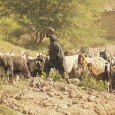By Salman Javed –
The plight of the Indus River Dolphins is well known by now due to the efforts of the World Wildlife Fund in Pakistan, less known is the plight of the Asian Black Bear, the Goitered Gazelle, the Markhor, the Sand Cat and the imperiously beautiful Snow Leopard. These are just some of the animals threatened with extinction in this country.
Fueled by industry and large scale development projects, the ecological trend of loss, fragmentation and degradation of natural habitats, like forest areas, rangelands, freshwater and marine ecosystems, are reducing biodiversity and the population of native animal and plant species.
There is a pressing need to not only make practical efforts at conservation of wildlife and nature, but also to create enough social awareness that unchecked industry and infrastructure growth can at least start being questioned.
Pakistan inherited several laws for environmental protection from the British Raj and new policies regarding this issue have continuously been formulated since its independence. Environmental protection and ecology are included in the parallel legislative list of Pakistan’s 1973 constitution. In 1983, the Pakistan Environmental Protection Ordinance was approved. This highlighted the need to have a framework of environmental laws in Pakistan to deal with emerging national issues related to the environment.
Meanwhile, wildlife conservation legislation inherited from the British was superseded by the West Pakistan Wildlife Protection Ordinance, 1959. Apart from prohibiting the killing of certain species of fauna, this legislation made provision for the declaration of Game Sanctuaries, in which hunting was prohibited, and Game Reserves in which hunting was controlled under license, but did not protect the habitat against settlement, cultivation, grazing and other forms of exploitation.
A Wildlife Enquiry Committee was set up in 1968 to review inter alia the existing conservation legislation based on recommendation by World Wildlife Fund. The legislation was drafted by this committee and with minor modifications was subsequently adopted at provincial level through the provisions of various acts and ordinances.
This was the first time in the history of Pakistan that wildlife legislation made an attempt to provide for the conservation of habitat, although limited to protected areas and species other than game animals. These initiatives resulted in the establishment of 4 National Parks, 44 Wildlife Sanctuaries and 65 Game reserves by the year 1978.
Following the recommendations of the Wildlife Enquiry Committee, a National Council for Conservation of Wildlife was established in July 1974. The NCCW has played an important role in encouraging the provincial wildlife departments for better management of protected areas particularly National Parks. Provincial Wild Life Departments are also encouraged to bring more areas under the protected network. NCCW in collaboration with provincial governments have been battling hard against bear, dog, mongoose and boar baiting.
As a result of the efforts of the NCCWA, by the year 2000 there was a network of 225 Protected Areas comprising 14 National Parks, 99 Wildlife Sanctuaries, 96 Game Reserves, and 16 Unclassified Reserves (private, proposed or recommended) in Pakistan. The total area covered by these Protected Areas was 9,170,121 hectares which made up an impressive 10.4% of the total land area in the country.
Protected Areas are cordoned off from unrestricted public access, most National Parks have are ticketed and have maintenance and security details, while Game Reserves need special licenses issued by authorities like the local Wildlife Warden and provincial Wildlife Departments. Pakistan has declared 96 Game Reserves to be included in the Protected Areas, but the conservation activities are not implemented properly. Game Reserves, particularly on private lands, receive minimal protection due to the lack of legal provisions on land use.
The administration of National Parks is also handled by the provincial Wildlife Departments. After the implementation of the Biodiversity Action Plan, five new National Parks in (the now) Khyber Pakhtunkhwa and Azad Jammu Kashmir were established in 2005, bringing the total number of National Parks in this country to 19.
Some of the more famous ones include the Lal Sahunra National Park (Punjab), Kirthar National Park (Sindh), Khujrab National Park (KP), Chiltan Hazar Ganji National Park (Balochistan), Margalla Hills National Park (Islamabad) and Chitral Gol National Park (KP).
However, while these parks play a role in preserving natural habitats and generating public interest in conservation, the more eco-sensitive and focused conservation effort is the establishment of Wildlife Sanctuaries. A Wildlife Sanctuary is an area set aside as an undisturbed preservation and breeding ground where public access is restricted or regulated beyond National Parks and Game Reserves. Whereas settlement and grazing by domestic livestock is allowed in a National Park, such activities are prohibited in Wildlife Sanctuaries.
The main objective of a Wildlife Sanctuary is to protect flora and fauna from extinction. Hunting is strictly prohibited in these areas. At present there are 99 Wildlife Sanctuaries in Pakistan, 66 officially recognized by and up to the standards of the International Union for Conservation of Nature.
Here are some of the bigger and more prominent ones.
Astore/Baltistan Wildlife Sanctuaries
Covering 800 sq km in total, these two areas are on the north side of the Astore Valley in Gilgit-Baltistan, east of Nanga Parbat, on either side of the Indus. They are prominent for being conservationist spots for the endangered Astore Markhor, a large species of wild goats unique to this region of the world, in addition to the endangered Snow Leopard, Brown Bear and the Lynx.
Cholistan Wildlife Sanctuary
The Cholistan desert area in the south eastern portion of the province of Punjab contains some of the most rare and interesting wildlife in Pakistan. Some of the rare animals of this region are the Desert Wolf, Indian fox, Red fox, Jackal, Indian Grey Mongoose, Nilgai Antelope, Saker Falcon, Black-backed Vulture and Saw-scaled Viper. An area of about 6,533 sq km has been declared as a Wildlife Sanctuary inside the desert.
Hub Dam Wild Life Sanctuary
The Hub Dam is Pakistan’s third largest dam. It is situated in the north of Karachi bordering the Kirthar National Park. A large water storage reservoir was constructed in 1981 on the Hub River, in a region of arid plains and low stony hills. Much of the shoreline is steeply shelving and stony, but there are many shallow bays and small islands. The greater part of the reservoir (in Balochistan) is unprotected; the eastern shore and area south of the Dam (in Sindh) are protected in the Kirthar National Park and Hub Dam Wildlife Sanctuary, respectively. The lake formed by the dam covers an area of 70 sq km and is an ideal place for bird watching. There is plenty of waterfowl in the lake, both resident and migratory. The surrounding hills are home to the Urial, the Sindh Wild Goat, Chinkara Gazelle, the Pangolin and numerous other birds and reptiles.
Nara Desert Wildlife Sanctuary
The Nara desert provides refuge to a large number of wildlife in the Sindh province. The Nara Canal area, a chain of some 200 freshwater, brackish and saline lakes and marshes stretching for about 150 km along either side of the Nara Canal from Sorah in the north to Sanghar in the south, is known to be of great importance for wintering waterfowl and other wildlife.
The largest population of the endangered Mugger Crocodile in Pakistan is found here.
Chasma and Taunsa Barrage Dolphin Sanctuary
The Chashma and Taunsa Barrage are declared Wildlife Sanctuaries by the Punjab government.
A very important breeding, staging and wintering area for a wide variety of waterfowl, regularly exceeding 20,000 birds, the area is also the biggest preservation spot of the endangered Indus Dolphin. Since the 1970s, the population of the Indus Dolphin has been stabilized and even significantly increased here.
Rann of Kutch Wildlife Sanctuary
The Rann of Kutch Wildlife Sanctuary lies in the southeast of the province Sindh near the border with India. The marshy Runn of Kutch and its surrounding desert area in Sindh is one of the best natural habitats for a numbers of animal and birds in the province. This area is known to be a breeding ground for
Flamingoes and a staging ground for Pelicans, Cranes, Storks and many species of waterfowl.
This area also used to have the only population of the Indian Wild Ass or Onager in Pakistan. Unfortunately they are thought to have been exterminated.
Sukkur and Guddu Barrage Dolphin Reserve
This area was declared a reserve for the Indus Dolphin in 1974. A stretch of about 135 km of the Indus River from Sukkur Barrage upstream to Guddu Barrage, the reserve includes the full width of the river when in spate and a strip of land 7 km wide on either side of the river.
The river area between Sukkur and Guddu barrage contains the largest population of the endangered Indus Blind River Dolphin, which is unique to Pakistan. The population has risen steadily due to the efforts of WWF-Pakistan and the Sindh Wildlife Board. Current population is thought to be around 400-500 in number.
The writer is a journalist based in Lahore































































































